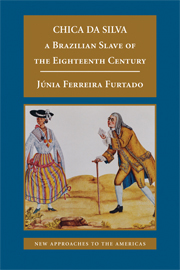Book contents
- Frontmatter
- Contents
- Acknowledgments
- Preface
- Maps
- Introduction to the English Edition
- 1 Land of Stars
- 2 Chica da Silva
- 3 The Diamond Contractors
- 4 Black Diamond
- 5 The Lady of Tejuco
- 6 Life in the Village
- 7 Mines of Splendor
- 8 Separation
- 9 Disputes
- 10 Destinies
- 11 Chica-que-manda
- Abbreviations
- Suggested Reading
- Index
- Plate section
9 - Disputes
Published online by Cambridge University Press: 05 September 2014
- Frontmatter
- Contents
- Acknowledgments
- Preface
- Maps
- Introduction to the English Edition
- 1 Land of Stars
- 2 Chica da Silva
- 3 The Diamond Contractors
- 4 Black Diamond
- 5 The Lady of Tejuco
- 6 Life in the Village
- 7 Mines of Splendor
- 8 Separation
- 9 Disputes
- 10 Destinies
- 11 Chica-que-manda
- Abbreviations
- Suggested Reading
- Index
- Plate section
Summary
Some, there, in the rugged pits,
rot away in the rivers,
while others, far off, reap the profits
of these mines of martyrdom.
THE GRIJÓ ESTATE
As was customary, Chief Judge João Fernandes de Oliveira embarked for the Realm with a retinue of personal slaves to serve him and make his long voyage more comfortable. He left behind the cliffs of Tejuco, which he would never set eyes on again, along with the mountain ranges and rivers of Minas. From the decks of his ship he bade farewell to the tropical heat, to the fresh Brazilian mornings, and the sweltering afternoons with their lazy siestas. Upon arrival in Lisbon, he settled comfortably into the house his father had constructed in Lapa, where he saw fit to make some additions, including the installation of a tile panel along the main staircase depicting Brazilian scenes.
The staff that served him at the mansion included slaves, six servants with varied skills and crafts, and other trusted aides, some of whom had been brought over from Brazil. In 1776, he is known to have had a butler, Maurício Pedro de Araújo; a buyer, Bartolomeu Vaz Lourenço, the contractor's longest-serving charge; and a coach driver, bodyguard, and cook, named José Gomes Dias, Luís José de Sousa, and Manuel do Nascimento. The house must have had a total staff of about twenty, including employees and slaves, of whom six were of the former contractor's strictest confidence and personal service.
Information
- Type
- Chapter
- Information
- Chica da SilvaA Brazilian Slave of the Eighteenth Century, pp. 239 - 258Publisher: Cambridge University PressPrint publication year: 2008
